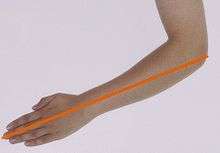Ell
| Ell | |
|---|---|
 The ell was originally a cubit, later replaced by the cloth-ell or "double ell". | |
| Unit information | |
| Unit of | Length |
| Unit conversions | |
| 1 in ... | ... is equal to ... |
| Inches | 18 |
An ell (from Proto-Germanic *alinō, cognate with Latin ulna)[1] is a unit of measurement, originally a cubit, i.e., approximating the length of a man's arm from the elbow ("elbow" means the bend or bow of the ell or arm) to the tip of the middle finger, or about 18 inches (457 mm); in later usage, any of several longer units.[2][3] In English-speaking countries, these included (until the 19th century) the Flemish ell ( 3⁄4 of a yard), English ell ( 1 1⁄4 yards) and French ell ( 1 1⁄2 yards), some of which are thought to derive from a "double ell".[4][5]
Several national forms existed, with different lengths, including the Scottish ell (≈37 inches or 94 centimetres), the Flemish ell [el] (≈27 in or 68.6 cm), the French ell [aune] (≈54 in or 137.2 cm)[6] the Polish ell (≈31 in or 78.7 cm), the Danish alen (24 Danish inches or 2 Danish fod: 62.7708 cm), the Swedish aln (2 Swedish fot ≈59 cm) and the German ell [Elle] (Hamburg, Frankfurt, Cologne, Leipzig: 57.9 cm)
Select customs were observed by English importers of Dutch textiles: although all cloths were bought by the Flemish ell, linen was sold by the English ell, but tapestry was sold by the Flemish ell.[6]
In England, the ell was usually 45 in (1.143 m), or a yard and a quarter. It was mainly used in the tailoring business but is now obsolete. Although the exact length was never defined in English law, standards were kept; the brass ell examined at the Exchequer by Graham in the 1740s had been in use "since the time of Queen Elizabeth".[7]
The Viking ell was the measure from the elbow to the tip of the middle finger, about 18 inches. The Viking ell or primitive ell was used in Iceland up to the 13th century. By the 13th century, a law set the "stika" as equal to 2 ells which was the English ell of the time.[8] An ell-wand or ellwand was a rod of length one ell used for official measurement. Edward I of England required that every town have one. In Scotland, the Belt of Orion was called "the King's Ellwand".[9][10]
Ell (Scots)
The Scottish ell (Scottish Gaelic: slat thomhais) was standardised in 1661, with the exemplar to be kept in the custody of Edinburgh.[11] It comes from Middle English elle.[12]
It was used in the popular expression
- "Gie 'im an inch, an he'll tak an ell" (equivalent to "Give him an inch, and he'll take a mile" or "... he'll take a yard", and closely similar to the English proverb "Give him an inch, and he'll take an ell", first published as "For when I gave you an inch, you tooke an ell" by John Heywood in 1546[13]).
The Ell Shop (1757) in Dunkeld, Perth and Kinross (National Trust for Scotland), is so called from the 18th century iron ell-stick attached to one corner, once used to measure cloth and other commodities in the adjacent market-place. The shaft of the old 17th century Kincardine Mercat cross stands in the square of Fettercairn, and is notched to show the measurements of an ell.
Scottish measures were made obsolete, and English measurements made standard in Scotland, by act of parliament in 1824.
The Scottish ell was equivalent to:
- Scottish measures: 3 1⁄12 feet (i.e. 37 Scottish inches or 37.059 imperial inches[14])
- Metric system: 94.1318 cm
- Imperial system: 1.03 international yards, approx. 37.1 inches
References
| Wikimedia Commons has media related to Ell. |
- ↑ http://www.oed.com/viewdictionaryentry/Entry/60511 "ell, n.1". OED Online. December 2011. Oxford University Press. (accessed February 20, 2012).
- ↑ The Diagonal. Yale University Press. 1920. p. 98. Retrieved 6 February 2012.
- ↑ Charlton Thomas Lewis; Hugh Macmaster Kingery (1918). An elementary Latin dictionary. American book company. p. 198. Retrieved 6 February 2012.
- ↑ James Robinson (of Boston.) (1857). The American elementary arithmetic. J.P. Jewett & co. p. 94. Retrieved 6 February 2012.
- ↑ Daniel O'Gorman (1853). Intuitive calculations; the readiest and most concise methods. p. 48. Retrieved 6 February 2012.
- 1 2 Brayshaw, Tom S., ed. Brayshaw's Mathematical Desk Companion. Chesterfield, England: Thomas Brayshaw Ltd., Edition 16, 1955
- ↑ Knight, Charles (1840). The Penny magazine of the Society for the Diffusion of Useful Knowledge, Volume 9. London: Society for the Diffusion of Useful Knowledge.
- ↑ Nancy Marie Brown (2007). The Far Traveller : Voyages of a Viking Woman, pp. 236, 276. Harcourt. OCLC 85822467.
- ↑ infoplease.com, OED s. Ell-wand.
- ↑ AR Littlewood. "The measurements of cricket". ESPN cricinfo.
- ↑ Concise Scots Dictionary, chief editor Mairi Robinson, Aberdeen University Press, 1987, p 817
- ↑ Dictionary of the Scots Language
- ↑ Heywood, John (1546). A dialogue conteinying the nomber in effect of all the prouerbes in the englishe tongue, compacte in a matter concernyng two maner of mariages, etc. London: Thomas Berthelet. Full text of 1874 reprint
- ↑ Dictionary of the Scots Language
- This article incorporates text from "Dwelly's [Scottish] Gaelic Dictionary" (1911).
Further reading
- Collins Encyclopedia of Scotland
- Scottish National Dictionary and Dictionary of the Older Scottish Tongue
- Weights and Measures, by D. Richard Torrance, SAFHS, Edinburgh, 1996, ISBN 1-874722-09-9 (NB book focusses on Scottish weights and measures exclusively)